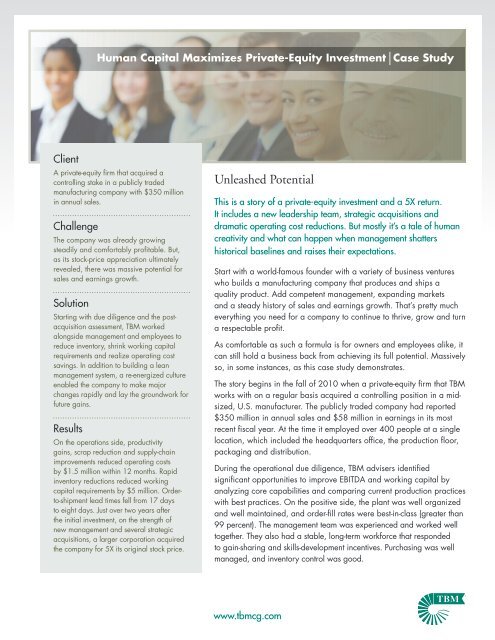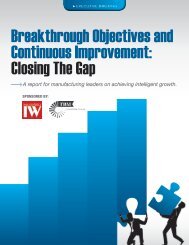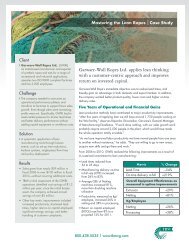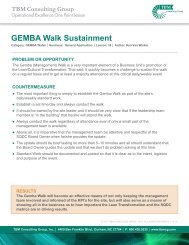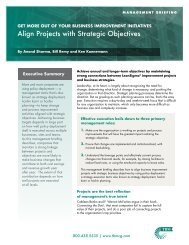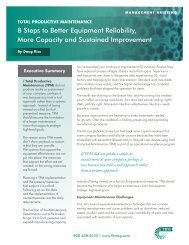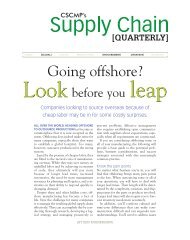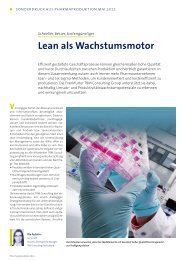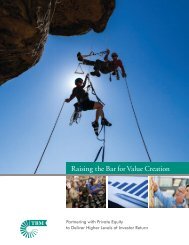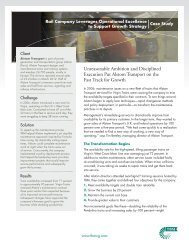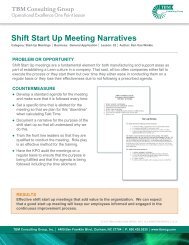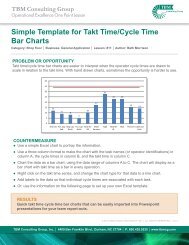Case Study - TBM Consulting Group
Case Study - TBM Consulting Group
Case Study - TBM Consulting Group
Create successful ePaper yourself
Turn your PDF publications into a flip-book with our unique Google optimized e-Paper software.
Human Capital Maximizes Private-Equity Investment <strong>Case</strong> <strong>Study</strong><br />
Client<br />
A private-equity firm that acquired a<br />
controlling stake in a publicly traded<br />
manufacturing company with $350 million<br />
in annual sales.<br />
Challenge<br />
The company was already growing<br />
steadily and comfortably profitable. But,<br />
as its stock-price appreciation ultimately<br />
revealed, there was massive potential for<br />
sales and earnings growth.<br />
Solution<br />
Starting with due diligence and the postacquisition<br />
assessment, <strong>TBM</strong> worked<br />
alongside management and employees to<br />
reduce inventory, shrink working capital<br />
requirements and realize operating cost<br />
savings. In addition to building a lean<br />
management system, a re-energized culture<br />
enabled the company to make major<br />
changes rapidly and lay the groundwork for<br />
future gains.<br />
Results<br />
On the operations side, productivity<br />
gains, scrap reduction and supply-chain<br />
improvements reduced operating costs<br />
by $1.5 million within 12 months. Rapid<br />
inventory reductions reduced working<br />
capital requirements by $5 million. Orderto-shipment<br />
lead times fell from 17 days<br />
to eight days. Just over two years after<br />
the initial investment, on the strength of<br />
new management and several strategic<br />
acquisitions, a larger corporation acquired<br />
the company for 5X its original stock price.<br />
Unleashed Potential<br />
This is a story of a private-equity investment and a 5X return.<br />
It includes a new leadership team, strategic acquisitions and<br />
dramatic operating cost reductions. But mostly it’s a tale of human<br />
creativity and what can happen when management shatters<br />
historical baselines and raises their expectations.<br />
Start with a world-famous founder with a variety of business ventures<br />
who builds a manufacturing company that produces and ships a<br />
quality product. Add competent management, expanding markets<br />
and a steady history of sales and earnings growth. That’s pretty much<br />
everything you need for a company to continue to thrive, grow and turn<br />
a respectable profit.<br />
As comfortable as such a formula is for owners and employees alike, it<br />
can still hold a business back from achieving its full potential. Massively<br />
so, in some instances, as this case study demonstrates.<br />
The story begins in the fall of 2010 when a private-equity firm that <strong>TBM</strong><br />
works with on a regular basis acquired a controlling position in a midsized,<br />
U.S. manufacturer. The publicly traded company had reported<br />
$350 million in annual sales and $58 million in earnings in its most<br />
recent fiscal year. At the time it employed over 400 people at a single<br />
location, which included the headquarters office, the production floor,<br />
packaging and distribution.<br />
During the operational due diligence, <strong>TBM</strong> advisers identified<br />
significant opportunities to improve EBITDA and working capital by<br />
analyzing core capabilities and comparing current production practices<br />
with best practices. On the positive side, the plant was well organized<br />
and well maintained, and order-fill rates were best-in-class (greater than<br />
99 percent). The management team was experienced and worked well<br />
together. They also had a stable, long-term workforce that responded<br />
to gain-sharing and skills-development incentives. Purchasing was well<br />
managed, and inventory control was good.<br />
www.tbmcg.com
Engagement Enables Improvements<br />
“Like a lot of companies that aren’t in the midst of a crisis,<br />
they were doing many things fairly well,” recalls Keith<br />
Yeater, <strong>TBM</strong> Vice President and client manager for this<br />
engagement. “But the owners, prompted by some recent<br />
market activity, were convinced that they were falling<br />
behind and weren’t keeping up with their competitors.”<br />
The company lacked a clear vision and direction, and<br />
a lukewarm embrace of lean practices in operations<br />
and the supply chain created some major opportunities.<br />
Specifically, based on the due diligence analysis, total<br />
capacity could be doubled with minimal capital investment,<br />
and the entire footprint could support a 4X capacity<br />
increase. Better inventory management would free up<br />
millions of dollars in working capital. The potential EBIDTA<br />
benefit—stemming from higher machine utilization, better<br />
labor allocation and supply chain improvements—ranged<br />
from $5 million to $8 million per year.<br />
Getting Down to Business<br />
After the acquisition was final, the transformation began.<br />
To build a world-class management team, the privateequity<br />
firm brought in a new CEO from a much larger<br />
corporation. He hired new marketing, sales, legal and<br />
operations leaders. They ultimately replaced or created<br />
new positions for over half of the executives and senior<br />
managers. During the first 18 months the company also<br />
made two complementary acquisitions, one for $40 million<br />
and the other for $150 million.<br />
To capture the targeted cost savings and inventory<br />
reductions, work on the operations side began with an<br />
initial assessment formulated by the management team<br />
with <strong>TBM</strong>’s guidance. It included a thorough analysis of<br />
sales, costs and inventory. For example, when the team<br />
looked closely at inventory, then valued at $37.3 million,<br />
they found that 22 percent was actually unusable and<br />
several quality assurance holds hold items were over a<br />
year old.<br />
The management team then created a current-state valuestream<br />
map based on direct observations of production<br />
processes and material flow that helped identify<br />
improvement targets. To establish priorities they rated<br />
the opportunities based on impact and difficulty, and<br />
incorporated them into a future-state map and a detailed<br />
go-forward plan.<br />
Coming out of the assessment, management’s high-level<br />
objectives were to improve labor productivity by 25-35<br />
percent, double raw-material inventory turns, improve<br />
finished-goods turns, and revamp the quality system to<br />
eliminate the need for 100 percent inspection of incoming<br />
material. Getting there would require the implementation of<br />
a hybrid build-to-order/build-to-stock model using pull-based<br />
(lean) methodologies, and establishing a robust sales-andoperations-planning<br />
(S&OP) process that fully integrated input<br />
from the sales team and key customers. Other improvement<br />
activities included the introduction of visual management<br />
tools, improvements in machine utilization, scrap reduction<br />
and extensive employee training.<br />
Value Creation Timeline<br />
Year #1<br />
September<br />
Due Diligence<br />
October<br />
PE Firm Acquires<br />
Controlling Stake<br />
November<br />
Operational<br />
Assessment<br />
Year #2<br />
February<br />
New CEO<br />
May<br />
New V.P.<br />
Operations<br />
Timeline continues on next page<br />
www.tbmcg.com
Human Capital Maximizes Private-Equity Investment <strong>Case</strong> <strong>Study</strong><br />
“On the soft side, they also wanted to establish<br />
internal operational improvement capabilities by<br />
introducing a continuous improvement management<br />
system and developing a lean program leader,”<br />
adds Yeater. “I don’t think anyone fully realized,<br />
after the tools and mindset had been fully<br />
introduced, how much pent-up creativity would be<br />
released among the employees.”<br />
This is a critical element of a sustainable business<br />
transformation that’s often glossed over in turnaround<br />
stories. In part because the company was financially<br />
stable and growing, and their jobs weren’t<br />
threatened, employees were open to trying new<br />
things. While the direction came from the top, the<br />
rapid execution of so many changes in such a short<br />
period of time depended on their full engagement.<br />
The company’s new V.P. of Operations lived by the<br />
tenet that the role of business leaders is to enable<br />
everyone to reach their maximum potential, and<br />
his job as a “servant leader” was to unleash and<br />
focus their energy and ideas. He instilled a culture<br />
of experimentation and problem solving (and<br />
acceptance of failure) that propelled people at<br />
the company to innovate and make value-adding<br />
changes. Coupled with some audacious goals, it’s<br />
a powerful formula for maximizing the potential of<br />
any business. Such a culture can be created much<br />
faster than most managers think it can.<br />
Rapid Transformation<br />
Actual Fiscal Year Savings<br />
(not annualized)<br />
Labor – Productivity improvement<br />
and overtime reduction...................... $450,000<br />
Yield improvement and<br />
scrap reduction................................. $260,000<br />
Quality testing efficiency ................... $55,000<br />
Sourcing, transportation, ................... $485,000<br />
utilities and maintenance<br />
Inventory interest expense ................. $250,000<br />
(assumes 5% cost of capital)<br />
Total P&L Savings $1,500,000<br />
Inventory Reduction .......................... $5,000,000<br />
Total Benefit $6,500,000<br />
Operational Metrics<br />
Improvements<br />
Order lead time ............................... Reduced from<br />
17 to 8 days<br />
Operating equipment efficiency ............. +15%<br />
Incoming inspection lead time............. Reduced by 5 days<br />
On-time delivery .............................. 99.5%<br />
UP<br />
June<br />
Complementary<br />
Acquisition #1<br />
Year #3<br />
March<br />
Stock at 2X<br />
purchase price<br />
April<br />
Complementary<br />
Acquisition #2<br />
June<br />
Operational<br />
improvements<br />
show up in<br />
annual financials<br />
5X ROI<br />
December<br />
Divesture<br />
www.tbmcg.com
All told, in one 12-month period, <strong>TBM</strong> helped the<br />
management team and employees completely<br />
redesign the plant’s work schedule, execute 25<br />
cross-functional kaizen events, negotiate a new<br />
lease that reduced plant floor space by 85,000<br />
square feet, manage 20 percent volume growth,<br />
significantly improve material flow, successfully<br />
integrate the two acquisitions, and save over $2<br />
million in hard costs, with another $2 million in<br />
savings on the immediate horizon.<br />
During this time, the operational improvements<br />
along with the management changes and<br />
acquisitions captured the attention of investors. The<br />
company’s stock price first doubled and then really<br />
took off when several large corporations made<br />
competing buyout offers. The private-equity firm<br />
ultimately realized a 5X gain on its initial investment.<br />
Such financial gains—representing future potential<br />
as much as results achieved—offer a lesson for<br />
other businesses competing favorably in profitable<br />
Three-Year Change In Stock Price<br />
categories with quality products. There might not be any incentive<br />
from current ownership or the market to make radical changes.<br />
But the opportunity for doing something extraordinary with human<br />
capital can generate tremendous value for management teams who<br />
aren’t satisfied with average performance.<br />
About <strong>TBM</strong> <strong>Consulting</strong> <strong>Group</strong><br />
<strong>TBM</strong> is a global operations management consulting firm that maximizes enterprise value and accelerates growth<br />
by working with clients to leverage operational excellence. Our clients achieve growth rates 3-5X their industry<br />
average and EBITDA growth at least 2X their topline. We focus on results with a bias for action and work side by<br />
side with our clients to immediately improve EBITDA, accelerate organic growth, ensure the rapid realization of<br />
results from newly acquired businesses, and generate immediate and long-term balance sheet improvements. Our<br />
subject-matter professionals average 10–25 years of operational, management and executive experience in the<br />
manufacturing sector and none are career consultants. We leave behind a customized framework and structure<br />
for lasting change using our proprietary LeanSigma ® approach, which has been continuously improved since we<br />
introduced it over 20 years ago.<br />
05/2013 <strong>TBM</strong>, the <strong>TBM</strong> logo and LeanSigma are registered trademarks of <strong>TBM</strong> <strong>Consulting</strong> <strong>Group</strong>, Inc.<br />
Join us on<br />
<strong>TBM</strong> <strong>Consulting</strong> <strong>Group</strong><br />
www.tbmcg.com<br />
Our<br />
Blog<br />
China • Brazil • France • Germany • India • Mexico • United Kingdom • United States


